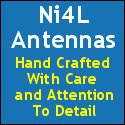Author Archive
 SOTA W0C 10-10-10 Challenge Report
SOTA W0C 10-10-10 Challenge Report

We had a great time going after the W0C 10-10-10 SOTA Challenge. (See 2021 Colorado SOTA and 14er Event ) For activators, the objective was to activate 10 summits higher than 10k feet in 10 days. It turned out that some previous commitments would not allow us to do 10 days of activating, so we smushed 10 summits into 6 days. With careful choice of summits and doing multiple summits in a day, we put together a plan.

Saturday and Sunday started off with the Colorado 14er Event, so we opted to do Pikes Peak on Saturday and Mount Evans on Sunday. These are both drive-up summits, so not a lot of hiking. As previously reported, we had some good luck with 1.2 GHz from those summits. Then, on Monday we hiked Puma Peak and Little Puma, two 11k summits in South Park. On Tuesday, we did three summits on one day: Dicks Peak, 10090 and 10715. These three hikes were not particularly difficult but doing all three made for a full day.

On Wednesday, we took the Jeep up to Mosquito Pass and hiked two 13ers: Mosquito Peak and London Mountain. We had previously activated those two summits in 2018. Finally, on Thursday, we did our tenth summit with Walt/W0CP and Jerry/K0ES, one of our favorites: South Monarch Ridge. Walt and Jerry worked the HF bands while we did VHF/UHF. That was a slacker day, because we rode the tram up from Monarch Pass.

The weather was consistently fantastic, with no thunderstorms in sight. The smoke from western wildfires was thick at times and can be seen in some of the photos.
The Bands
As usual, we operated above 50 MHz, focusing on 2m, 70cm and 23cm FM operation. Most of the contacts were on 2m FM but we had significant activity on the other bands. The 1.2 GHz work was really fun: Using 1.2 GHz in the Colorado 14er Event. I made 162 contacts and Joyce made 94, for a total of 256 for the week. Not bad!
Thanks to all of our chasers and fellow activators: AC0FT, AC0FY, AC0V, AD1CT, K0AVU, K0BEJ, K0EHR, K0ES, K0FYR, K0GPA, K0GPA, K0MGL, K0MOS, K0REW, K0SJP, K0TRD, K1DDN, K5RHD, K6TUY, K7ASB, KA4EPS, KB0KQI, KB6VHF, KC0PBR, KC3BHI, KC5CW, KD0MRC, KD0VHD, KD0YOB, KD8EQA, KE0BTX, KF0DGK, KF0FOG, KG5APL, KJ4DER, KL7GLK,
KL7IZW, KM4PEH, KM5TY, KN0MAP, KX0R, KX3DX, N0DET, N0EMU, N0IPA, N0IVN, N0KM, N1SMB, N1XCO, N8XBD, W0ADV,
W0BV, W0CP, W0JSL, W0OOD, W0RW, W1KGH, W3REM, W5IG, W6AUN, W7UM, WA0KXO, WB0JNS, WB0TNH, WZ0N
Challenge Results
The results for the W0C 10-10-10 Challenge have been posted, for both activators and chasers. Here are the Activator results:

Six activators met the challenge of doing at least 10 summits during the event. That was our goal…not pursuing the top of the list but we did want to get 10 summits done. I am fifth on the list and K0JJW came in at sixth. We had the same number of SOTA points because we did the same summits. I had more QSOs though.
It was a fun event and we were happy to be able to activate 10 summits. Fortunately, the weather was good, otherwise we might have gotten rained out on the longer days.
73 Bob K0NR
The post SOTA W0C 10-10-10 Challenge Report appeared first on The KØNR Radio Site.
 My POTA Activation Guidelines
My POTA Activation Guidelines
Joyce/K0JJW and I have been doing Parks On The Air (POTA), in addition to our normal Summits On The Air (SOTA) activations. Sometimes we do both simultaneously. (See More on SOTA and POTA.) SOTA will probably continue to be our top priority because, well, you just can’t beat operating from the summit of a mountain.

SOTA and POTA
The programs have a lot in common but still have some significant differences. One of the key differences is that SOTA inherently puts you outdoors and away from your vehicle. This happens naturally if you hike some distance to get to a summit. But even on a drive-up mountain, the rules (W0C ARM) say:
Operations must not be in, or in the close vicinity of a motor vehicle, cannot use a permanent electrical power source, nor use a fossil fuel generator in any fashion. No part of the station may be connected in any way with the motor vehicle. All equipment must be operated from portable power source (batteries, solar cells, etc).
I have come to appreciate the wisdom of these restrictions as it helps keep the program “backpack portable,” without being overly restrictive. POTA does not have these restrictions, so it is common to see POTA activators operating from inside vehicles, inside RVs, even inside buildings using commercial power. Quite different from SOTA and I suppose that’s just fine. It does provide a higher degree of flexibility and radio hams can choose to participate in a manner that works for them. Certainly, this is a good thing for physically challenged individuals.

Here is a definition of “park” as it applies to national, state and local parks.
Park (noun):
an area of land, usually in a largely natural state, for the enjoyment of the public, having facilities for rest and recreation, often owned, set apart, and managed by a city, state, or nation.
The main idea of visiting a park is for people to enjoy being outdoors in a natural setting.
My POTA Rules Guidelines
Everyone gets to decide “how to POTA” as long as they stay inside the POTA rules. We’ve adopted these guidelines to keep POTA oriented towards outdoor, portable radio operating.
- Set up outdoors Get outside the vehicle and find a place to set up outdoors. At a picnic area or campsite, this might be using a picnic table or it might be setting up on a stump, on a rock, or on the ground. Whatever works. Even a tailgate-style operation is better than just sitting in the car.
- Take a hike Before or after the activation, take a hike. Get some exercise and explore the park. A mile or two of walking in the forest is usually a good thing.
- See the park Some parks are not very hikeable, but you can still explore what is special about the place. Look around to see what is interesting about the park and why it exists.
Note that these are guidelines and not strict rules. This is what we try to do for a POTA activation. There will be times when this is not practical and that’s OK, too. Sometimes we’ll do a Drive-Up/Drive-By activation when time is limited or the weather is bad. For example, I recall a recent winter activation in K-4407 where the temperate was -3 deg F. We stayed in the truck for that one!
So keep on POTAing and having fun with ham radio.
These are my thoughts, what do you think?
73 Bob K0NR
The post My POTA Activation Guidelines appeared first on The KØNR Radio Site.
 Using 1.2 GHz in the Colorado 14er Event
Using 1.2 GHz in the Colorado 14er Event
Last weekend we held the Colorado 14er Event (Aug 7 and 8), the annual mountaintop event in Colorado. A group of us used this weekend as an opportunity to make 1.2 GHz (23 cm) Summits On The Air (SOTA) contacts: K0NR, K0JJW, KM4PEH, K5RHD, W0ADV, KL7IZW, W0RW, KC5RW, and K0BEJ.

Many of the 1.2 GHz operators used the Alinco DJ-G7T triband handheld transceiver. This radio covers the 2m, 70cm and 23cm bands. The RF output on 23 cm is only 1 watt but it is the lowest-cost way of getting a signal on that band.
Pikes to Uncompahgre
On Saturday, Joyce/K0JJW and I were on Pikes Peak (W0C/FR-004) and worked Randy/K5RHD on Mount Evans (W0C/FR-003) at a distance of 97 km (60 miles). Signals were strong and we had no problem making those contacts.
We also worked David/W0ADV on Uncompahgre Peak (W0C/RG-001) at a distance of 227 km (141 miles). David used the Alinco HT driving a 16-element Comet Yagi. We had a bit more power (10 watts) from our Kenwood TM-541A transceiver, also driving a Comet Yagi antenna. Signals were strong in both directions and these QSOs were a new personal best for both Joyce and me on 1.2 GHz.
Evans to Sunshine
On Sunday, we moved to Mount Evans and Randy/K5RHD activated Pikes Peak. We worked Randy on that peak, the reverse of the QSO on the previous day. Meanwhile, David/W0ADV was climbing two 14ers in the San Juan Mountains: Redcloud Peak (W0C/RG-002) and Sunshine Peak (W0C/RG-004). These two summits are close to each other, separated by a saddle, so it is common to climb them as a pair.

David’s route had him climbing Redcloud first and then continuing on to Sunshine, then returning to Redcloud on the way back down. We worked him on Sunshine and on the return trip over Redcloud, as he headed back to the trailhead.

We had trouble hearing David on Sunshine Peak but his signal was just strong enough that we could complete the contact. His signal was stronger from Redcloud, a surprise because the two summits are close in elevation. I expected them to be about the same in terms of signal path and strength. David reported that there was a ridge to the northeast of Sunshine that might be blocking the signal, but it was not in the way for Redcloud.
So these contacts with Sunshine Peak set a new personal best for both Joyce and me on 1.2 GHz (244 km, 152.6 miles). David clearly did the hard work, summiting two 14ers in a day. (We were on a drive-up mountain with a short hike.) Thanks, David/W0ADV!
I was very pleased with the results from the 14er weekend. Now I am wondering what’s next for us concerning 1.2 GHz. We can probably make radio contacts further out but it is going to depend on the topography of the path. We will have to do some investigation on additional summits to try.
73 Bob K0NR
The post Using 1.2 GHz in the Colorado 14er Event appeared first on The KØNR Radio Site.
 Can You Hear a 1-dB Change?
Can You Hear a 1-dB Change?
Decibels are commonly used in electronic communications to describe and compare signal levels. I’ve often heard that one dB is considered to be the smallest change that a typical person can detect by ear. I recently came across this website audiocheck.net that is set up to generate different audio tones and to do a blind test of how small of a change you can detect.
I started with testing for 6-dB and 3-dB changes. Easy Peasy. Then I tried the 1-dB test. I could detect the change in level fairly consistently but I did have to concentrate. Continuing on to the 0.5-dB change, I had a very high failure rate. It was very difficult to detect that small of a change. So I have to conclude that 1 dB is about the limit for a change I can hear.
How about you? Take the test on the website and let us know how you did.
There are many other audio tests to explore on that site, including the highest frequency you can hear, the minimum pitch change you can hear, etc. Check it out: www.audiocheck.net
73 Bob K0NR
The post Can You Hear a 1-dB Change? appeared first on The KØNR Radio Site.
 GMRS: Basic Radio Communications
GMRS: Basic Radio Communications

Lately, I’ve been talking with people in search of basic radio communications for their friends or family. They end up talking to me because someone steered them to ham radio as a solution and I teach ham radio license classes. Of course, I am happy to pull them into the wonderful ham radio world but sometimes the General Mobile Radio Service (GMRS) might be a better way of meeting their needs.
I have a GMRS license and have written about it. See GMRS: The Other UHF Band. GMRS is a good fit for local communications, perhaps just using simplex or with repeaters, if available in your area. FCC regulations (Part 95) require you to have a license (and pay a fee) to use GMRS. Unlike ham radio, the license does not require you to pass an exam and the license is valid for you and your family members.
Common Uses
GMRS works well for family communication “around town” or some local area. Depending on the type of equipment used, simplex range of 10 or 15 miles is achievable, maybe more. The use of repeaters can extend this a lot further. You might even decide to put a GMRS repeater on the air, which is not too difficult of a project.
Another common use of GMRS is when a group is traveling down the highway in multiple vehicles. Yes, you might be able to just use your mobile phone to stay in touch but a two-way radio may be a better solution (especially when mobile phone coverage is poor or non-existent). Many off-road vehicle clubs have discovered GMRS and use it for communicating during trail rides.
GMRS is also a great tool for outdoor activities such as camping, hunting, hiking and skiing. It is a handy way of staying in touch with your tribe, while not depending on the mobile phone network.
GMRS Is Not FRS

GMRS often gets confused with the Family Radio Service (FRS). They both include the use of inexpensive, low-power handheld radios and they share many of the same frequencies. When the FCC authorized FRS, GMRS was already an established radio service and it squeezed FRS into the same band. FRS radios were limited to lower output power, so many manufacturers decided to offer combination FRS/GMRS radios, which operated at higher power levels. The user was supposed to obtain a GMRS license to use this type of radio but most people didn’t bother with it. (Most people probably didn’t even know of the requirement.) The FCC also specified 2.5 kHz (half deviation) FM for the FRS radios on the same channels as the existing 5 kHz deviation GMRS radios. Intermingling an unlicensed radio service with a licensed service was probably not a wise move. In general, the FCC regulations caused a lot of confusion between the two services.
In 2017, the FCC adopted a major revision to the GMRS rules to clean up some of the problems with the service. In particular, the regulations now prohibit the sale of combination FRS/GMRS radios. A great idea but a bit too late in the game.
The GMRS rules are pretty easy to understand, so take a look here: FCC Part 95 – Personal Radio Services
Equipment
There are basic handheld transceivers for GMRS. They look and act a lot like the FRS radios that are widely available, but GMRS can provide more capability. An advanced handheld radio will have support for using repeaters (transmit offset) and higher power (up to 5 watts).

To dramatically improve the radio range, you can use GMRS mobile and base stations that can run even more power, up to 50 watts. More importantly, you can use external antennas on your vehicle or your house. These can make a huge difference in performance. (FRS is limited to handheld transceivers and the permanently-attached rubber duck antenna.)
For radio amateurs, this should all sound pretty familiar. GMRS looks and acts a lot like an FM transceiver on the 440 MHz (70 cm) band. It is a great alternative for local radio communications for people not interested in a technical hobby such as amateur radio.
The post GMRS: Basic Radio Communications appeared first on The KØNR Radio Site.
 2021 Colorado SOTA and 14er Event
2021 Colorado SOTA and 14er Event

The Summits On The Air (SOTA) program originated in the United Kingdom but has propagated to most countries around the world. The program came to Colorado on May 1st, 2010 with Steve/WGØAT sending a CQ from Mount Herman, just west of Monument. Today, the SOTA program in Colorado (called WØC-SOTA) is very active with roughly 180 activators that operate from Colorado summits.
To celebrate our 10th Anniversary, WØC-SOTA is organizing a 10-10-10 Event with a challenge for Activators and Chasers alike. (Activators operate from summits, Chasers try to contact them.)
Activator challenge: Activate 10 (or more) 10K feet (or higher) summits (in Colorado/WØC) within 10 days.
Chaser challenge: Chase Activators on 10 different (or more) qualifying WØC summits (10K or higher) within the 10 days.
Event Date: We will kick-off the event in conjunction with the Colorado 14er event on August 7th, 2021 and conclude on August 16th.
Everybody is invited to participate, either as an Activator or a Chaser. Block off these days in your calendar now and start planning for how you can participate. Feel free to operate as much or as little as you would like. It is all about having fun messing around with radios. Any HF, VHF or UHF band can be used for making SOTA contacts, with the most popular ones being 40m (CW & SSB), 20m (CW & SSB) and 2m (FM).
Note that the recommended 2m FM frequencies for the 14er event have changed to:
146.580 FM North America Adventure Frequency
146.550 FM Simplex Alternate
146.490 FM Simplex Alternate
146.520 FM National 2m FM Calling Frequency
(as needed, please don’t hog the calling frequency)
There will be a leaderboard on the W0C-SOTA website showing all participants who meet one of the challenges. More details will be announced on the WØC-SOTA Website as soon as they are hashed out.
For more information on the SOTA program in general, see the worldwide SOTA website.
Full Disclosure: May 1 is actually the 11th Anniversary, but the COVID-19 Pandemic interfered in 2020, so we are catching up.
The post 2021 Colorado SOTA and 14er Event appeared first on The KØNR Radio Site.
 A Decibel Is Still A Decibel
A Decibel Is Still A Decibel
 When discussing signal levels and power output, hams like to say things like:
When discussing signal levels and power output, hams like to say things like:
Using higher power isn’t important because it only gives you one additional S unit
and
You’ll lose some power in the coax but you won’t even notice a few dB
These statements are often true and at the same time may be completely wrong. I’ve noticed that radio amateurs pushing the limits of their station pay close attention to every decibel they gain or lose. This is especially true at VHF/UHF frequencies where signals may be weak. A dB here, a dB there, the next thing you know it adds up to something big!
Definitions
First, let’s make sure we have a few definitions right. The decibel (dB) is defined as the ratio of two power levels:
dB = 10 log (P2/P1)
One decibel corresponds to a 26% increase in power level. A well-known rule of thumb is that doubling the power corresponds to a 3 dB increase. Similarly, chopping the power in half drops the signal level by 3 dB. A 10 times increase in power is 10 dB. (Voltage can also be used to calculate decibel relationships but to keep it simple, I’ll just use power.)
The S Unit is normally defined as a 6-dB change in signal level, which is a factor of 4 in power. (Your S meter may or may not actually follow this rule but that is a topic for another day.)
Power Level
Let’s compare a few different power levels to get a feel for how decibels and S units behave. Let’s use a 5 watt QRP level as our reference power. If we crank up the power to 100 watts, we have 10 log (100/5) = 13 dB increase in power level. This is slightly more than two S units (2 x 6 dB), so we would expect the S meter on the other end to read 2 units higher.
Now suppose we kick in our linear amplifier to produce a 1 kilowatt RF signal. This power level is 10 log (1000/5) = 23 dB higher than the 5 watt signal, or roughly four S units.
Now if our QRP signal was a solid S9 to start with, adding another 23 dB on top of it may not be that significant. The station can be heard at S9 or can be heard even louder at S9 + 23 dB. Except when there’s a pile of stations all calling that rare DX…then the loudest station tends to be heard. Crafty operating skill and good luck may overcome the power difference.
But consider the other extreme. Our QRP station is being heard right at the noise floor on the receive end. The two stations are struggling to complete the contact and the propagation path degrades by 2 dB. Now the QRP station is below the noise and uncopyable. We increase our power to 100 watts and gain 2 S units…still not very strong but the ability to receive the signal improves dramatically. Crank it up to 1000 watts and you gain another couple of S units and the copy is quite good. The key point is that changes in signal level matter most at the margin, when you can just barely copy the signal. (By the way, there is nothing wrong with running QRP…many ops enjoy the challenge of making contacts with low power.)
At the receiver, our ability to recover the signal is determined by the signal-to-noise ratio (SNR). A higher noise floor at the receiver means it will be more difficult to hear the signal coming in. The type of modulation being used may also make a big difference. Good old CW and the WSJT modes use a narrower bandwidth and will get through when wider-band modulation (SSB, FM) fails. In all cases, a stronger signal works better.
Antennas
Antenna systems also increase our signal level…and they do it for both transmit and receive. I recently did some comparisons of VHF antennas from a SOTA summit. My 2m Yagi antenna has 6 dB of gain (referenced to a dipole) and my comparisons showed that the performance of this antenna was good enough to pull some signals out of the noise to be solid copy. This occurred when the other station’s signal was right at the noise floor (using my lower gain antennas) such that the 6 dB improvement had a significant impact.
 Sometimes hams will say that VHF is just line-of-sight propagation and that the signal level doesn’t matter much. This is partially true but often we are stretching for contacts beyond line-of-sight. Take a look at this article: The Myth of VHF Line-Of-Sight. This is another case where we are operating on the margin and every dB matters.
Sometimes hams will say that VHF is just line-of-sight propagation and that the signal level doesn’t matter much. This is partially true but often we are stretching for contacts beyond line-of-sight. Take a look at this article: The Myth of VHF Line-Of-Sight. This is another case where we are operating on the margin and every dB matters.
Feedline loss can cause us to lose decibels, which impacts both transmit and receive performance. If your coaxial cable is short, then the losses may be negligible. Increasing cable length and increasing frequency produce more loss. For example, 100 feet of RG-8X has only 1.1 dB of loss at 10 MHz. Increase the frequency to 146 MHz and the loss jumps to 4.5 dB, using the Times Microwave cable calculator. That means 50 watts of power at the transmitter turns into 17.7 watts at the other end of the cable. Using LMR-400 coax reduces the attenuation to 1.5 dB.
Summary
You can choose to ignore small changes in your signal level. A dB here or there may not make a big difference with casual ham radio operating. But these losses tend to add up and may become significant. Most importantly, just a few dB may be the critical difference between making a radio contact or not, when operating at the margin.
The post A Decibel Is Still A Decibel appeared first on The KØNR Radio Site.













